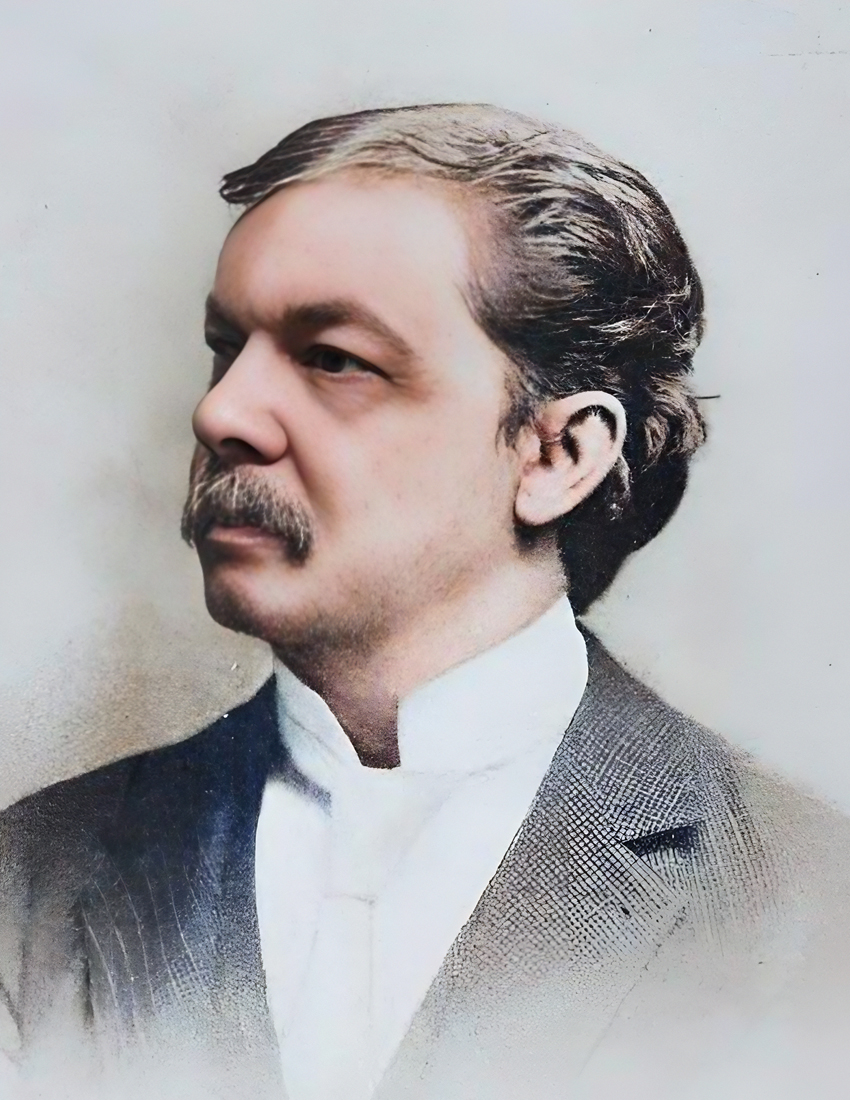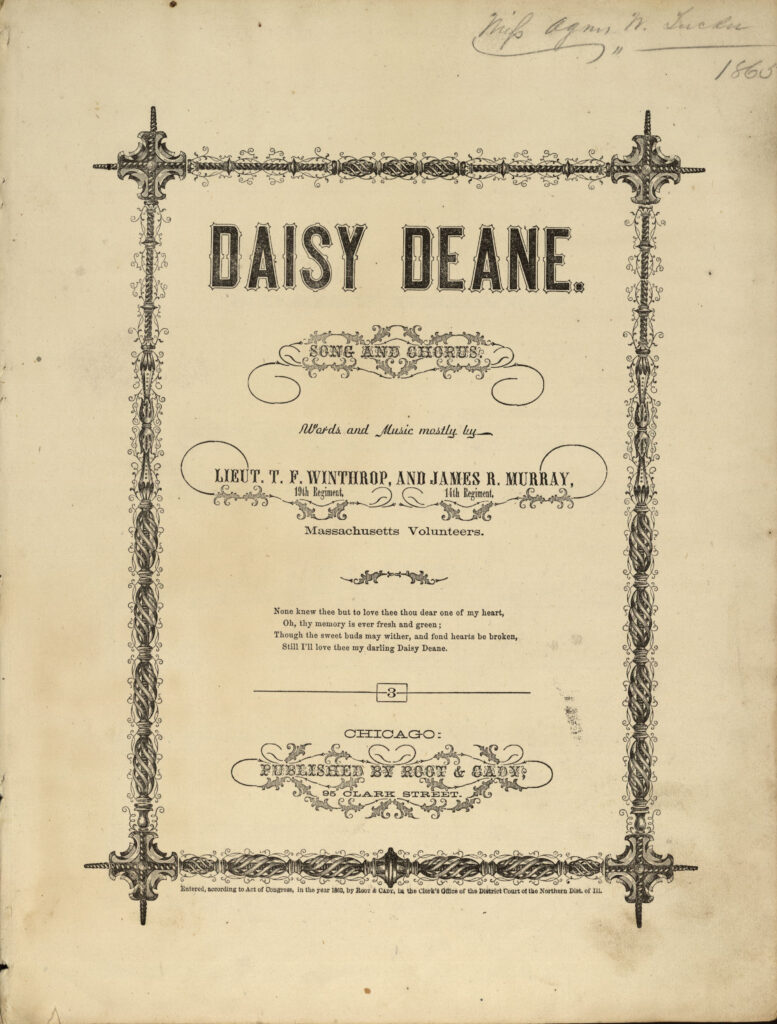Born: March 7, 1841, Ballard Vale, Andover, MA.
Died: March 10, 1905, Cincinnati, OH.
Buried: Spring Grove Cemetery, Cincinnati, OH.
James Ramsey Murray

Hymns by James Murray
Daisy Deane: A Wartime Ballad That Captured America’s Heart
Amid the tumult of the Civil War, a tender melody emerged from an unlikely place. “Daisy Deane,” penned by Lieutenant T.F. Winthrop and James Ramsey Murray in a war-torn camp, captured the hearts of soldiers and civilians alike. This poignant ballad, with its vivid imagery of springtime meadows and lost love, offered a bittersweet respite from the harsh realities of conflict.
Published by Root & Cady, “Daisy Deane” quickly became more than just another wartime composition. Its haunting refrain, “None knew thee but to love thee thou dear one of my heart,” echoed the sentiments of many separated from their loved ones. The song’s enduring appeal is evident in its numerous recordings, from Grandpa Jones’ 1949 version to more recent interpretations by the Nashville Mandolin Ensemble.
“Daisy Deane” stands as a powerful reminder of music’s ability to transcend the boundaries of time and circumstance, showing us that even in the darkest moments, the human spirit finds solace in beauty and remembrance.
In the midst of a Virginia camp during the American Civil War, a young soldier named James Ramsey Murray put pen to paper, crafting a melody that would outlive the conflict and touch hearts for generations to come. This moment, seemingly ordinary amidst the chaos of war, marked the beginning of a musical journey that would shape American hymnody and Christmas music for decades to follow.
Early Life and Scottish Heritage
Murray’s story begins in Ballardvale, Massachusetts, in 1841. Born into a family of skilled Scottish craftsmen, he inherited a rich cultural heritage that would later infuse his musical compositions. His father, Walter Murray, was reportedly the first spinner in the Ballardvale Mill, setting the stage for a life steeped in the rhythms of industry and innovation.
As a teenager, Murray found himself working for Henry Tyer, a rubber cement manufacturer. Yet the Lord, it seemed, had different plans for the young man. A severe illness struck, forcing Murray to reassess his life’s direction. It was during this time of reflection that Reverend Henry S. Greene, recognizing Murray’s innate musical talent, advised him to pursue a career in music. This guidance would prove pivotal, setting Murray on a path that would ultimately lead him to become one of America’s most beloved hymn writers.
Musical Beginnings
Murray’s musical education began in earnest at the Musical Institute in North Reading, Massachusetts. Under the tutelage of renowned instructors such as Lowell Mason, George Root, William Bradbury, and George Webb, he honed his craft and developed the skills that would later define his unique compositional style.
Civil War Years
The outbreak of the Civil War in 1861 saw Murray answering the call of duty. He enlisted as a musician in the Massachusetts 28th Infantry, later transferring to Andover’s Company H when regimental bands were discontinued. It was during this tumultuous period that Murray’s musical talents truly began to flourish.
His wartime composition “Daisy Deane,” a collaboration with his cousin Thomas Winthrop, became one of the biggest hits of the war years. Published by Chicago’s Root & Cady in 1863, this weepy ballad struck a chord with soldiers and civilians alike, offering a poignant reminder of home and loved ones in the midst of conflict.
Post-War Career
After the war, Murray’s career in music blossomed. He taught piano and singing in Andover before accepting a position with Root & Cady in Chicago. The Great Chicago Fire of 1871 forced him to return to Andover, but this setback was only temporary. In 1881, Murray moved to Cincinnati, where he would spend the remainder of his life and create some of his most enduring works.
Musical Contributions
It was in Cincinnati that Murray composed his most famous piece, an arrangement of “Away in a Manger” published in 1887. This simple yet beautiful rendition of the classic Christmas carol would become his most lasting legacy, sung in churches and homes across America each holiday season.
Murray’s influence extended beyond his compositions. He collaborated on The Pacific Glee Book, a singing lesson book that helped shape music education in America. His work with various publishers, including his role as editor of The Musical Visitor and his leadership in the publishing department of the John Church Company, allowed him to shape the direction of American sacred music in the late 19th century.
Later Life and Legacy
James Ramsey Murray’s life came to an end on March 10, 1905, in Cincinnati. He succumbed to Addison’s disease and was laid to rest in Spring Grove Cemetery. Yet his music lives on, a testament to the power of melody to transcend time and touch the human spirit.
From the battlefields of Virginia to the churches of America, Murray’s compositions continue to resonate with listeners today. His journey from a small-town craftsman’s son to a nationally recognized composer serves as a reminder of the transformative power of music and the enduring impact of a life dedicated to one’s passion.
As we sing “Away in a Manger” each Christmas, we not only celebrate the birth of Christ but also pay tribute to James Ramsey Murray, the man whose arrangement has become an integral part of our holiday traditions. His life’s work stands as a bridge between the tumultuous years of the Civil War and the rich musical heritage of modern America, a legacy that continues to enrich our cultural landscape.


